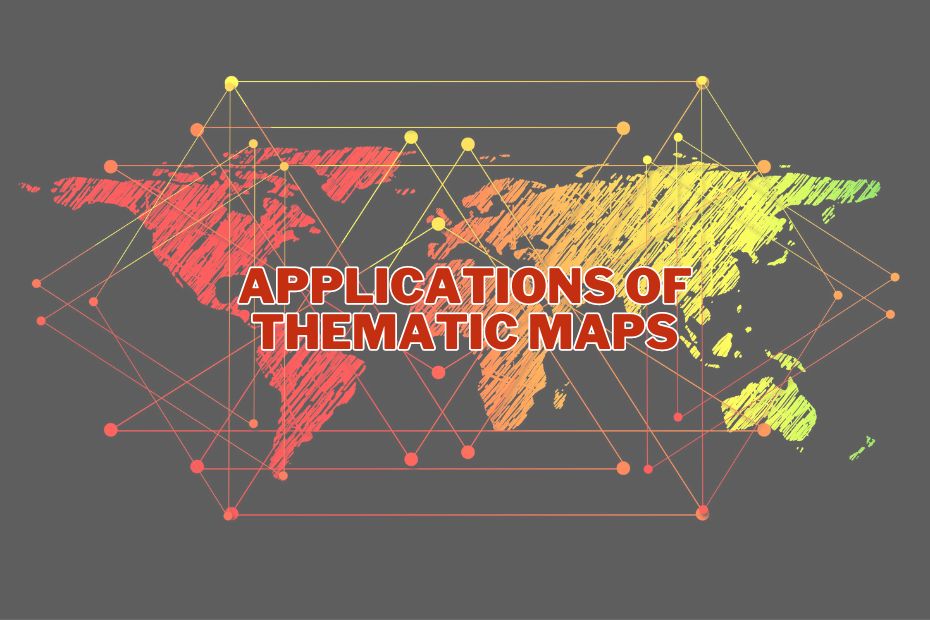Thematic maps are a powerful tool for visualizing and conveying complex data in a simplified manner. They offer a unique perspective on various subjects, making them invaluable in multiple domains. In this comprehensive guide, we will delve into the applications of thematic maps and explore their significance in different fields.
Thematic maps, distinct from general-purpose maps, serve as a crucial tool in visualizing and analyzing spatial data. Unlike traditional maps, which focus on geographic features, thematic maps emphasize specific themes or topics, such as population density or climate change.
Explore The Applications of Thematic Maps
Thematic maps are a versatile and invaluable tool with applications spanning across multiple sectors. From aiding in urban planning to enhancing disaster management, these maps enable us to make more informed decisions and gain valuable insights into our surroundings. Their ability to visualize data in an accessible manner makes them an essential asset in today’s data-driven world.
1. Understanding Patterns and Trends
Thematic maps excel in identifying and displaying patterns and trends. For instance, a choropleth map can vividly illustrate income distribution across a country, using color gradations to represent varying income levels. Such maps are instrumental in studying phenomena like population density, rainfall patterns, and disease outbreaks, transforming raw data into actionable insights.
2. Making Informed Decisions
In fields like urban planning, resource management, and disaster preparedness, thematic maps are indispensable. Consider a flood risk map: it can guide development projects in coastal areas by showing potential flood zones. This application demonstrates how thematic maps contribute to informed, data-driven decision-making.
3. Understanding Environmental Issues
Thematic maps are also pivotal in tracking environmental changes. They can chronicle issues like deforestation, climate change, and pollution levels. A map charting global temperature changes over decades, for example, offers a clear, visual representation of climate trends, making the abstract concept of global warming more concrete and understandable.
4. Visualizing Social and Economic Data
These maps also play a role in representing social and economic indicators, such as poverty rates, literacy levels, and access to healthcare. A map highlighting educational attainment across regions can inform policies and pinpoint areas needing attention.
5. Mapping History and Culture
Thematic maps can also depict historical events, migration patterns, and cultural diversity. A map tracing the spread of a language family across continents not only illustrates historical migrations but also sheds light on cultural evolution.
6. Engaging Learners and the Public
These maps enhance learning and public understanding of complex issues. Interactive thematic maps, used in education and citizen science projects, engage users in a hands-on manner, fostering a deeper connection with the data.
7. Planning and Logistics
In logistics and planning, thematic maps are invaluable. For example, a map showing city traffic flow patterns during peak hours can aid in transportation planning and emergency response management.
8. Exploring and Discovering
Thematic maps are essential in scientific exploration and geographical discovery. They help in mapping distributions of newly discovered species or geological formations, opening new frontiers in scientific research.
9. Tourism and Recreation
In the tourism industry, thematic maps are instrumental in guiding travelers. They highlight tourist attractions, hiking trails, and recreational areas, enhancing the overall travel experience.
The Future of Thematic Maps
Advancements in technology and data availability are shaping the future of thematic maps. Innovations like real-time thematic mapping and personalized cartography are expanding their applications and accessibility.
Conclusion
Thematic maps are more than just tools for displaying data; they are lenses through which we can better understand and interact with our world. Whether it’s for making informed decisions, understanding complex issues, or exploring new frontiers, the applications of thematic maps are as diverse as they are essential. Their role in aiding comprehension, decision-making, and discovery is invaluable, making them a key resource in our increasingly data-driven world.
FAQs: Applications of Thematic Maps
What Are Thematic Maps?
Thematic maps are specialized maps that represent a particular theme or topic, such as population distribution, climate patterns, or land use, using various visual elements like colors, symbols, and patterns.
How Are Thematic Maps Different from Topographic Maps?
Thematic maps focus on a specific theme or subject, while topographic maps primarily depict the physical features of an area, such as elevation, rivers, and roads.
What Software Can I Use to Create Thematic Maps?
There are several software options available for creating thematic maps, including ArcGIS, QGIS, and MapInfo. These tools offer a wide range of features for map design and data analysis.
How Do Thematic Maps Enhance Decision-Making?
Thematic maps simplify complex data, making it easier for decision-makers to understand and analyze. This, in turn, leads to more informed and effective decision-making in various fields.
